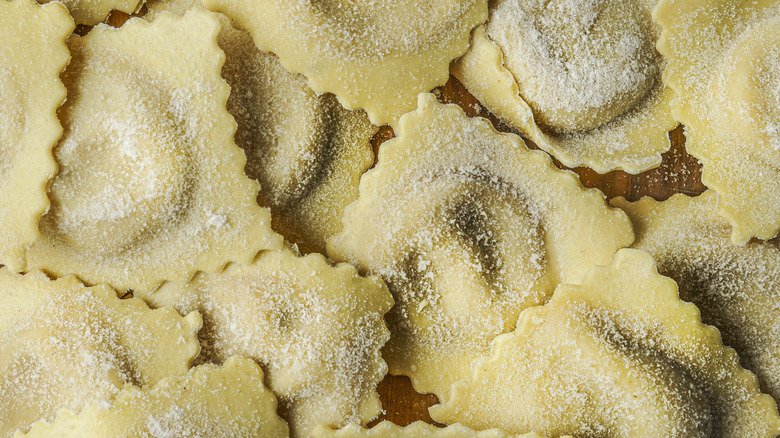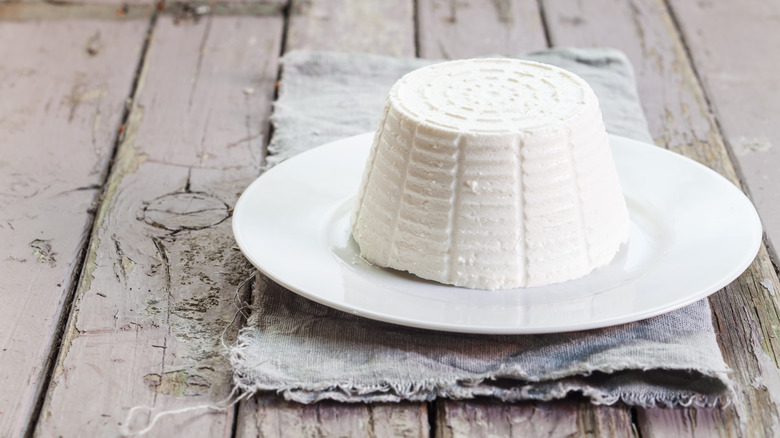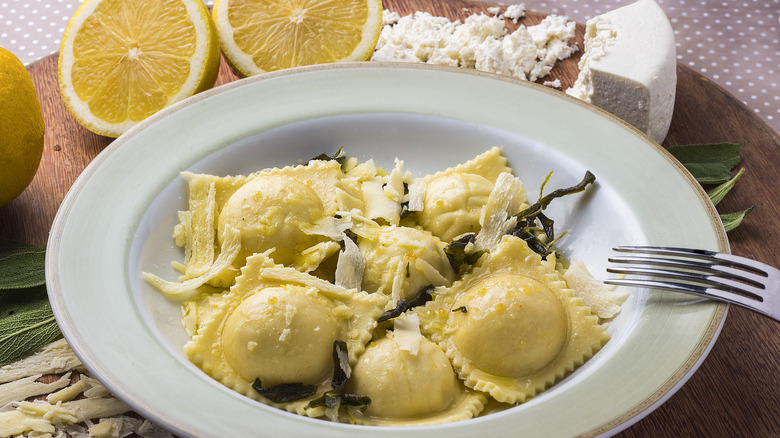The Essential Ingredient You Need For Both Savory And Sweet Ravioli
Of the great many filled pastas in Italian cuisine, from tortellini to stuffed shells to manicotti, perhaps the most well-known and beloved are the pillows of perfection known as ravioli. These creations can be homemade by your neighborhood nonna, or picked up from the freezer section of your favorite grocery store — but either way, they are versatile, craveable, and satisfying.
And while you can find them with a wide variety of fillings and pair them with your choice of sauces from traditional to experimental, there is one ingredient you can almost always reliably find inside — and that's ricotta cheese. This formaggio is a staple of Italian cuisine and the foundation for many classic dishes, but when it comes to ravioli, it's not just about staying authentic — it's essential.
Few cheeses have the range and consistency that make ricotta so ideal for just about any ravioli you can dream up. From savory to sweet, saucy to dippable and deep-fried, this cheese is the key ingredient for ravioli.
Why ricotta is the key to your ravioli
For a hint at understanding what ricotta cheese really is, you have to look no further than its name. Loosely translated, it means re-cooked, and the production method is truly representative of the Italian no-waste food philosophy, as it's created by cooking down the whey byproduct left behind after making other cheeses. The result is a fresh and fluffy cloud that is fairly neutral in flavor. Ricotta's main defining characteristic is a mild sweetness, and in fact, many descriptions focus more on its creamy quality than its particular taste.
For that reason, it easy to see why this creation became fundamental for so many Italian delights — adding lightness and texture without dominating in flavor. In the case of ravioli, which is often adapted for the season, region, or occasion, ricotta is a perfect vehicle to pad those pasta pillows without interfering with other elements. Whether that means simple herbs and spices, or more assertive additions that require extra body (think citrus, for example). Additionally, since fat is a super effective flavor transmitter, ricotta helps call attention to the flavors of other ingredients used in ravioli filling.
When making ricotta ravioli, it can be helpful to drain your cheese, since moisture can make for a sticky dough that's tough to seal. You can accomplish this with a cheesecloth, or simply by letting the ricotta sit in a strainer over the sink for about 20 minutes.
The range of ricotta ravioli
A simple fresh ricotta ravioli will usually incorporate some additional grated cheese, like parmesan, which brings a little saltiness to the table and helps bind your filling, too — and the result is pretty darn perfect. But ricotta's ability to easily adapt to other flavors gives you nearly total free reign over what you choose to stuff inside your ravioli, from spinach to pumpkin, beet to mushroom, or even a bright and sweet-tart lemon ricotta ravioli, in which the cheese helps tame the tang.
The ricotta stuffed inside will also play off whatever other ingredients you use. It's a great balancing element to the acidity of tomato sauce. A homemade ricotta ravioli with butter and sage sauce allows the herb and unctuous dairy topping to take center stage, while the filling itself gets depth from a sprinkle of nutmeg.
Because ricotta is so versatile, you'll find it in plenty of sweet applications, too, from cannoli to cakes and cookies. That means you can convert your pasta pillows into ravioli dolci – a sweet after-dinner treat — by creating a filling of the cheese along with chocolate chips, sugar, and spices like cinnamon. No matter the craving, by embracing ricotta as an indispensable ravioli ingredient, you can open up to all kinds of inspiration.


